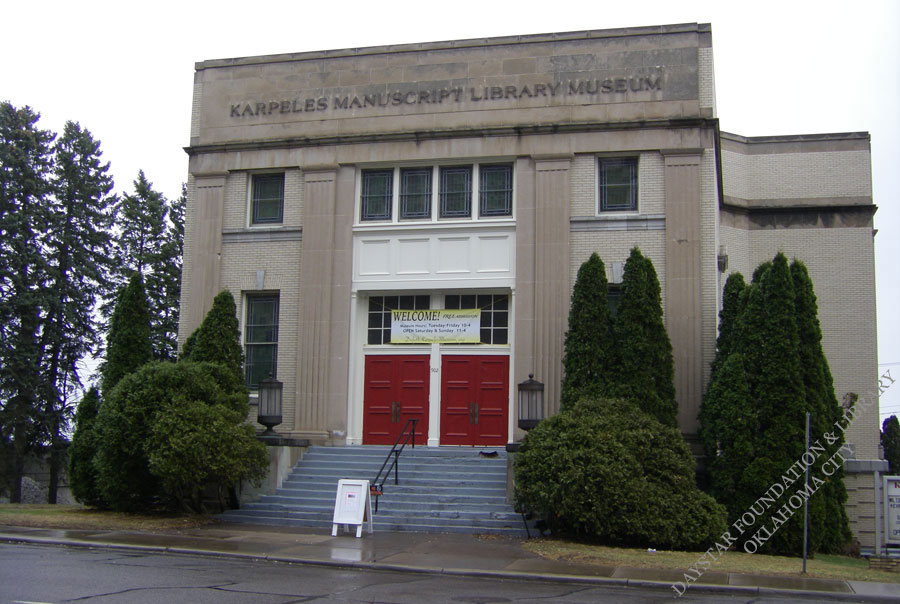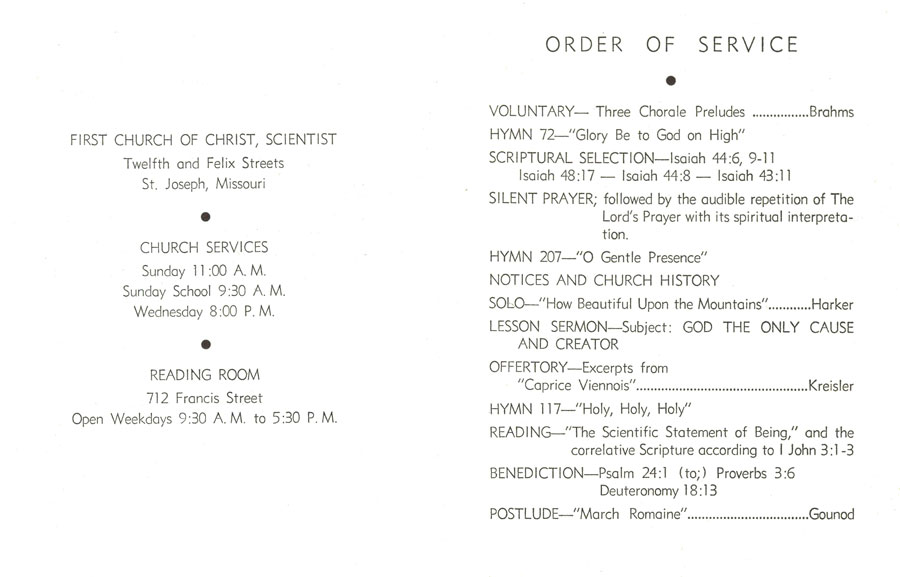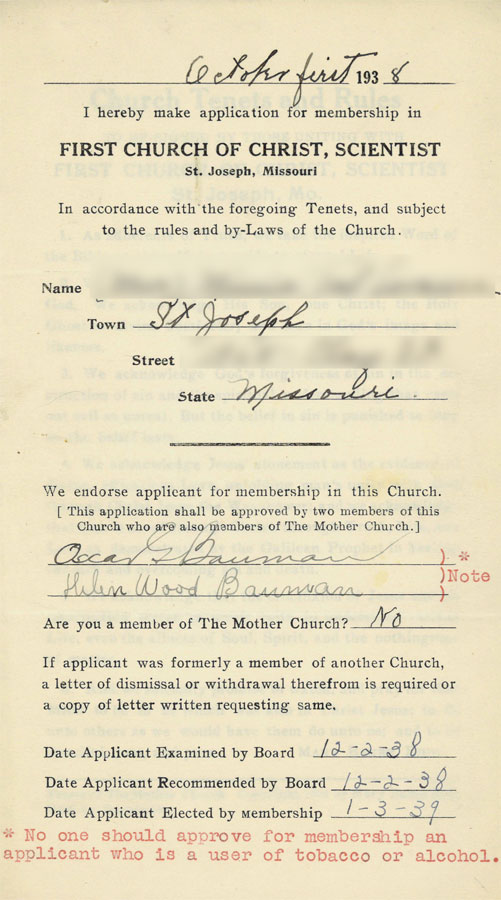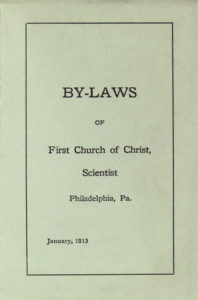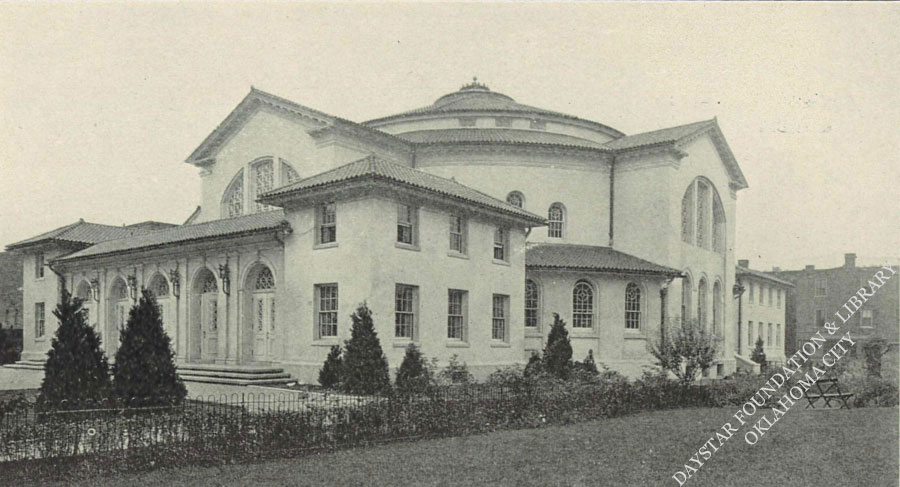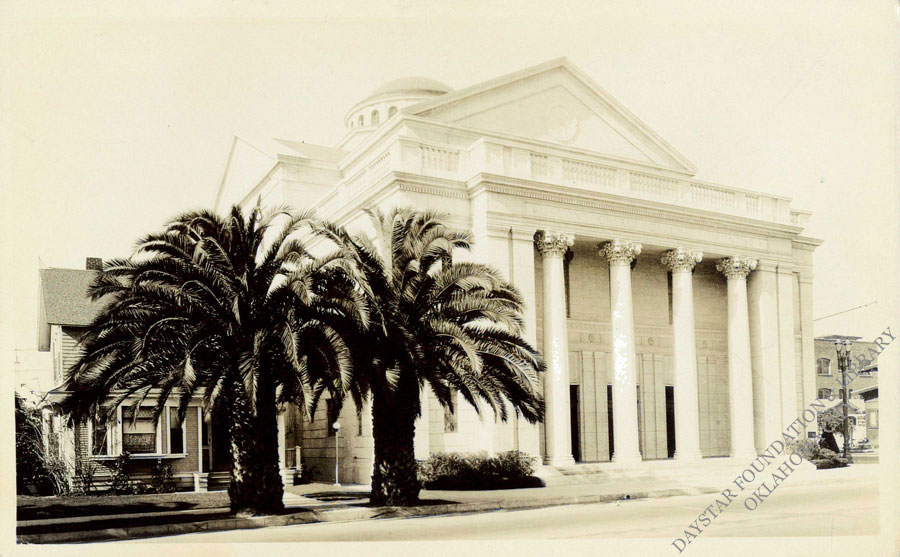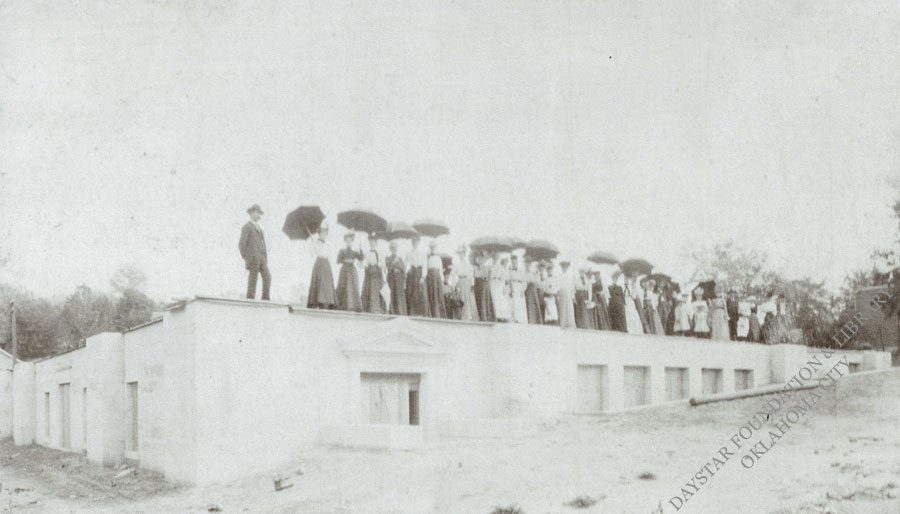
Structures of Truth and Love: Artifacts from Christian Science Branch Church History
Christian Scientists are well familiar with Mary Baker Eddy’s definition of Church on page 583 of her textbook, Science and Health with Key to the Scriptures, as a thought-provoking view of what the word church means—most importantly the spiritual meaning of that word. She writes:
“CHURCH. The structure of Truth and Love; whatever rests upon and proceeds from divine Principle. The Church is that institution, which affords proof of its utility and is found elevating the race, rousing the dormant understanding from material beliefs to the apprehension of spiritual ideas and the demonstration of divine Science, thereby casting out devils, or error, and healing the sick.”1
It was in the spirit of this insightful definition of church that the Daystar staff prepared an exhibit at the library titled “Structures of Truth and Love: Artifacts from Christian Science Branch Church History.”
Several years ago Daystar began an effort to photograph every Christian Science branch church building in the world for the historical record. This seems like a tall order, but we felt it was important to document the significant architectural legacy of Christian Science branch churches in recognition of their special place in each community they serve. And, of course, within these buildings, dedicated and grateful members have worked to bring Christian Science to the public through conducting weekly church services and testimony meetings, staffing Reading Rooms, and hosting Christian Science lectures. It was our desire to honor the commitment to the Cause of Christian Science manifested by these church members over the years that moved us to bring attention to the photos, as well as documents and artifacts related to branch church architecture and history in Daystar’s collection.
In preparing the exhibit, an effort was made to arrange the artifacts through the lens of typical Christian Science branch church member experiences—from building a new edifice, to becoming a church member, and finally in serving the membership and the public.
Embarking on a church edifice construction project has always been viewed as a significant step in the growth of a Christian Science branch church. Often a branch starts out as an informal group meeting in a private home, then grows into larger, rented quarters to hold services, until finally the next step becomes building a physical structure—signifying the permanent and sincere commitment of its members to serve the community through their demonstration of the healing truth of Christian Science. In an article in the November 1927 issue of The Christian Science Journal titled “Church Building in Christian Science,” Walter Zahler beautifully describes the ultimate outcome expected in the undertaking of such a project:
“The superstructure, therefore, which we are to erect is not a cold, inanimate edifice of stone, brick, and mortar, but a beautiful, living temple, filled with the light of spiritual understanding and the warmth of love. Its walls are the ennobled and useful lives of regenerated men and women; its pillars their good deeds and healing works, the whole crowned with service to mankind.”2
These “living temples” had to begin, in a practical sense, with an architectural design. One of the most prolific architects of Christian Science branch churches in the 20th century was Charles Draper Faulkner.
Charles Draper Faulkner, Sr., at construction site of First Church of Christ, Scientist, Miami Beach, Florida, March 1959 (Daystar Collection 20.7.6)
Faulkner, later, along with his son, Charles Jr., designed numerous branch churches across the United States for many years. In his 1946 book, Christian Science Church Edifices, Charles Sr. describes the importance of architectural design and of how the resultant physical structure speaks for the religion itself. He writes:
“What we do and how we do it will, from now on, declare to the world the real character of our own thinking, —and the value we, ourselves, place on the teachings of Christian Science.”3
“For the seed shall be prosperous; the vine shall give her
fruit, and the ground shall give her increase…” Zech. 8:12
The day ground is broken on a church building project is a momentous day. In Daystar’s collection there is a candid photo from one such event. On October 17, 1910, less than two months before Mrs. Eddy’s passing, the little band pictured here “broke the sod” at the corner of Main Street and Jefferson Avenue in Houston, Texas, to erect their new church edifice.
Groundbreaking, First Church of Christ, Scientist, Houston, Texas, Oct. 17, 1910 (Daystar Collection 16.13.10)
As construction commenced, the Houston Post reported, “The new church will be one of modern design and is to cost between $40,000 and $50,000. Work has been progressing steadily…and members of the church expect to occupy the completed structure next March.”4
Construction in progress, First Church of Christ, Scientist, Houston, Texas, 1911 (Daystar Collection 16.13.15)
The opening didn’t happen quite that soon, but the edifice did host its first services on October 11, 1911—almost one year to the day after the members broke ground.
The 1911 edifice remained in use until 1961, when a new, very modern building was constructed on the same location.
1961 edifice, First Church of Christ, Scientist, Houston, Texas
(Daystar Collection 16.13.17)
“…I lay in Zion for a foundation a stone, a tried stone, a
precious corner stone, a sure foundation…” Isaiah 28:16
The ceremonial laying of a cornerstone was commonly a quiet, even sacred event for Christian Science churches. These gatherings, often small, were usually accompanied by readings, or perhaps a short inspirational talk given by a practitioner or member of the branch church board. Sometimes the cornerstone held a sealed metal box containing the most current issues of the Christian Science periodicals and the writings of Mary Baker Eddy, the Discoverer and Founder of Christian Science.
Documentation of one such event appears in a photo from First Church of Christ, Scientist, Duluth, Minnesota. This cornerstone laying ceremony took place in October of 1912.
Laying of the cornerstone, First Church of Christ, Scientist, Duluth, Minnesota, October 1912 (Daystar Collection 16.7.575)
The first services were held in the completed building in 1914, and it was dedicated free of debt ten years later in 1924. The edifice was sold in 1993 and currently houses one of over a dozen nationwide locations of the Karpeles Manuscript Library Museum.
Former First Church of Christ, Scientist, Duluth, Minnesota
(Daystar Collection 18.6.12)
These Karpeles museums, many of which are housed in former Christian Science branch churches, host exhibits featuring selections from the Karpeles Manuscript Collection, the largest private collection of historical manuscripts and documents in the world, access to which is free to the public at each location.
“Let our superstructure be in keeping with our foundation. Let it manifest God’s presence, already established. Our superstructure must rise into individual demonstration, or the foundation will be of little value to mankind. Only through daily deeds and hourly communion with God can each individual see Christ’s church, already established.” 5
Following the laying of the cornerstone, congregations watch with eager anticipation as the superstructure of their new edifice rises from its foundation. Sometimes the process is slow, as some churches engage in construction only when funds are available, and then when cash is completely expended, pause the work until more supply becomes apparent and the project again moves forward. This was exactly the approach taken by First Church of Christ, Scientist, St. Joseph, Missouri, a town on the Missouri River about 50 miles north of Kansas City. While the cornerstone of the magnificent Beaux-Arts style building was laid in 1899, the first services were not held in the completed edifice until 1907.
We have two photos documenting this financially prudent strategy. Here members of the church are shown standing on the completed basement level of the edifice on May 13, 1906.
Members stand atop completed basement level, First Church of Christ, Scientist,
St. Joseph, Missouri, May 13, 1906 (Daystar Collection 19.8.6)
A church history for First Church, St. Joseph, included in Daystar’s collection indicates that they held their very first services in the basement and that this “…was a season of great rejoicing for the congregation of about 300 members.” The church had invited a member of the Christian Science Board of Lectureship, Irving Tomlinson of Boston, to give a public lecture on Christian Science in St. Joseph, and while there, he also addressed church members on the occasion of opening a portion of their new building for church services.
In this next photo, the edifice appears in late stages of construction with its members gathered in front wearing their Sunday best. The first services in the completed structure were held in the summer of 1907.
Construction near completion, First Church of Christ, Scientist, St. Joseph, Missouri, Summer 1907 (Daystar Collection 19.8.8)
“…let it not be said that church dedication is primarily the raising of funds to pay off indebtedness. Dedication is consecration to a holy purpose.”6
The next milestone in the history of a branch church is its dedication. Dedication services are occasions for humble joy and gratitude and are often marked by a distinct element not found in a typical Sunday order of service—the reading of a brief historical sketch of the church. First Church of Christ, Scientist, St. Joseph, did not dedicate their building until June 6, 1954, almost 47 years after it opened! Here is a look inside the dedication program from what was certainly a greatly anticipated day by the members. Take note of the “Church History” item following the reading of the Notices in the order of service.
Dedication Program, First Church of Christ, Scientist, St. Joseph, June 6, 1954 (Daystar Collection 19.8.10)
Although the St. Joseph church was sold by the membership in 2002, it still stands proudly as one of the most attractive buildings in the city and currently functions as an event venue.
Former First Church of Christ, Scientist, St. Joseph, Missouri
(Daystar Collection 13.20.16)
“When spiritually understood, the church does far more for its members than they can ever do for it. In the degree that each member realizes and demonstrates the spiritual idea of Church, he is effectively building up the Cause of Christian Science and maintaining the particular branch church with which he is affiliated, and he himself is bound to receive directly of the divine blessing.” 7
The weekly, sometimes daily, practical, hands-on work of branch church members to provide an active, public presence of Christian Science in their community not only ensures spiritually enriching experiences for church-goers but provides opportunities for growth for church members themselves—in serving their fellow man and in overcoming challenges through application of Christ Jesus’ example of loving one’s neighbor. Those interested in pursuing a commitment to branch church membership have traditionally started with submitting a membership application. Daystar’s collection includes several examples of such documents, but a recent acquisition holds special interest. Again, this item is from First Church of Christ, Scientist, St. Joseph, Missouri.
Membership application endorsed by Helen Wood Bauman, First Church of Christ, Scientist, St. Joseph, Missouri, October 1, 1938 (Daystar Collection 19.8.26)
Take note of who co-signed approval of this application from October of 1938. The signature on the line below her husband’s belongs to Helen Wood Bauman, who was at that time an active member of First Church, St. Joseph. Later she would become well known to the entire Christian Science Field while serving as Editor of the Christian Science periodicals for 22 years. Mrs. Bauman also served as President of The Mother Church in Boston in 1963, and as teacher of the 1958 and 1973 Normal classes, which are the courses of instruction taught to those who are selected to become authorized teachers of Christian Science.
One of the first items new branch church members receive is often a set of by-laws, or the governing policies and established procedures for operating the church. Historically, these were distributed in the form of small pamphlets. We have quite a large number of these in our collection, and they form an important record of polity for individual branch churches. Here is a 1913 example from First Church of Christ, Scientist, Philadelphia, Pennsylvania.
By-laws, First Church of Christ, Scientist, Philadelphia, Pennsylvania, 1913 (Daystar Collection 16.7.99)
This pamphlet is from the early years of First Church, Philadelphia, which broke ground in 1909, opened in 1910, and was dedicated in 1911. The building was sold in 1995 and is currently owned by the University of Pennsylvania.
First Church of Christ, Scientist, Philadelphia, Pennsylvania, 1911
(Daystar Collection 16.7.95)
One of the most vital activities a branch church can undertake is providing a Christian Science lecture for the public in its local area, the preparation, organization, and hosting of which takes the dedicated work of numerous church members. The fruit of the good work done by one lecture committee was captured in a photo Daystar obtained a few years ago. Second Church of Christ, Scientist, Salt Lake City, broke ground on its neo-classical edifice in 1915, held its first services in 1916, and was dedicated free of debt in 1918. Twenty years later, a photo was taken of a crowd exiting a Christian Science lecture held in the building in the winter of 1938.
Crowd exiting Christian Science lecture at Second Church of Christ, Scientist,
Salt Lake City, Utah, winter 1938 (Daystar Collection 18.1.110)
Notice the multitude in their finery pouring out of all three doorways and the cab idling curbside waiting for a fare. In that auditorium, which held 950 people, it appears there wasn’t an empty seat in the house for the lecture that day!
This type of dynamic church activity surely caught the attention and interest of the local community, so much so that these buildings became landmarks of interest for locals and visitors alike. As a result of the activity and interest these churches generated—not to mention the distinction of their architecture—scores of branch churches were photographed for postcards. While it may seem strange to us to create souvenirs of local churches today, it was more commonplace in the late 19th and early to mid-20th centuries, and Daystar’s collection includes over fifteen hundred postcards! Here are a few examples from every corner of the nation and the world.
First Church of Christ, Scientist, Skagway, Alaska
(Daystar Collection 737.12)
First Church of Christ, Scientist, Honolulu, Hawaii
(Daystar Collection 727.17)
First Church of Christ, Scientist, Spokane, Washington
(Daystar Collection 644.1)
Second Church of Christ, Scientist, Long Beach, California
(Daystar Collection 644.12)
Christian Science Society of Steamboat Springs, Colorado
(Daystar Collection 10.10.3)
First Church of Christ, Scientist, Fairmont, Minnesota
(Daystar Collection 727.30)
First Church of Christ, Scientist, Delray Beach, Florida
(Daystar Collection 865.5)
First Church of Christ, Scientist, Rockland, Maine
(Daystar Collection 727.25)
First Church of Christ, Scientist, Glasgow, Scotland
(Daystar Collection 13.16.2)
It seems apropos to close with a quote from an article titled “Church Building” which appeared in the September 8, 1928, issue of the Christian Science Sentinel, as it encapsulates well the intent and purpose of our exhibit on branch churches:
“The completed structure should embody beauty, dignity, and simplicity, and should express the characteristics of quietude and peace. It will stand as an oasis in the desert of human fears and longings toward which the parched thought of sin-sick humanity may turn with the sweet assurance of surcease from its sickness and woes; its atmosphere will be that animus of spirituality which the true Christian Scientist naturally exhales, and which is the result of obedience to the teaching of Jesus, ‘This is my commandment, That ye love one another, as I have loved you.’ This attitude of brotherly affection and regard is conducive to growth and expansion, and is the fulfillment of God’s requirement. Where these conditions obtain, it may safely be said that we have builded well.”8
The materials shared here represent just a selection of the items featured in our new exhibit. We invite you to come to visit us at the library to experience this exhibit, as well as the rest of Daystar’s historical collection.
1 Mary Baker Eddy, Science and Health with Key to the Scriptures (Boston: Trustees under the Will of Mary Baker Eddy, 1934), p. 583.
2 Walter Zahler, “Church Building in Christian Science,” The Christian Science Journal, November 1927, p. 432.
3 Charles Draper Faulkner, Christian Science Church Edifices (Chicago: Charles Draper Faulkner, 1946), p. 35.
4 “Among the Churches,” Christian Science Sentinel, December 3, 1910, p. 271.
5 Andrew G. Bodwell, Jr., “Church Building,” The Christian Science Journal, December 1916, p. 514.
6 Viva L. Besse, “Dedication,” The Christian Science Journal, November 1955, p. 565.
7 Richard P. Verrall, “Church Building and Maintenance,” The Christian Science Journal, November 1932, p. 446.
8 Frederic W. Edgett, “Church Building,” Christian Science Sentinel, September 8, 1928, p. 26.






